Chemistry > GCSE MARK SCHEME > GCE Chemistry B H433/01: Fundamentals of chemistry Advanced GCE Mark Scheme for November 2020 (All)
GCE Chemistry B H433/01: Fundamentals of chemistry Advanced GCE Mark Scheme for November 2020
Document Content and Description Below
GCE Chemistry B H433/01: Fundamentals of chemistry Advanced GCE Mark Scheme for November 2020 Oxford Cambridge and RSA Examinations GCE Chemistry B H433/01: Fundamentals of chemistry Advanced G... CE Mark Scheme for November 2020Oxford Cambridge and RSA Examinations OCR (Oxford Cambridge and RSA) is a leading UK awarding body, providing a wide range of qualifications to meet the needs of candidates of all ages and abilities. OCR qualifications include AS/A Levels, Diplomas, GCSEs, Cambridge Nationals, Cambridge Technicals, Functional Skills, Key Skills, Entry Level qualifications, NVQs and vocational qualifications in areas such as IT, business, languages, teaching/training, administration and secretarial skills. It is also responsible for developing new specifications to meet national requirements and the needs of students and teachers. OCR is a not-for-profit organisation; any surplus made is invested back into the establishment to help towards the development of qualifications and support, which keep pace with the changing needs of today’s society. This mark scheme is published as an aid to teachers and students, to indicate the requirements of the examination. It shows the basis on which marks were awarded by examiners. It does not indicate the details of the discussions which took place at an examiners’ meeting before marking commenced. All examiners are instructed that alternative correct answers and unexpected approaches in candidates’ scripts must be given marks that fairly reflect the relevant knowledge and skills demonstrated. Mark schemes should be read in conjunction with the published question papers and the report on the examination. © OCR 2020H433/01 Mark Scheme November 2020 2 Annotations Annotation Meaning Correct response Incorrect response Omission mark Benefit of doubt given Contradiction Rounding error Error in number of significant figures Error carried forward Level 1 Level 2 Level 3 Benefit of doubt not given Noted but no credit given IgnoreH433/01 Mark Scheme November 2020 3 Abbreviations, annotations and conventions used in the detailed Mark Scheme (to include abbreviations and subject-specific conventions). Annotation Meaning DO NOT ALLOW Answers which are not worthy of credit IGNORE Statements which are irrelevant ALLOW Answers that can be accepted ( ) Words which are not essential to gain credit __ Underlined words must be present in answer to score a mark ECF Error carried forward AW Alternative wording ORA Or reverse argumentH433/01 Mark Scheme November 2020 5 Section A Question Key Mark AO element 1 C 1 1.1 2 B 1 1.1 3 B 1 1.1 4 A 1 1.2 5 D 1 1.2 6 C 1 1.2 7 C 1 1.1 8 C 1 2.1 9 C 1 1.2 10 D 1 1.1 11 D 1 2.1 12 B 1 2.5 13 B 1 2.7 14 B 1 2.7 15 A 1 1.2 16 C 1 2.8 17 C 1 2.6 18 A 1 1.2 19 C 1 1.2 20 C 1 2.2 21 B 1 2.8 22 A 1 1.1 23 D 1 1.2 24 C 1 1.2 25 D 1 2.5 26 B 1 2.3 27 A 1 2.8 28 C 1 1.2 29 B 1 1.1 30 D 1 1.2H433/01 Mark Scheme November 2020 6 Section B Question Answer Mark AO Element Guidance 31 (a) C16H34 24½ O2 16CO2 + 17H2O 1 2.5 ALLOW multiples. IGNORE state symbols 31 (b) (i) Heterogeneous catalyst and reagents are in different states. 2 1.1 x2 Mark independently States, if given, must be correct, (g) and (S) for catalyst 31 (b) (ii) Provides a route of lower EA 1 1.1 Must mention activation, not just energy/enthalpy and alternate route. 31 (c) (i) Colourless gas turns brown 2 1.1 x 2 31 (c) (ii) N2 + O2 2NO 1 1.1 If state symbols are shown they must be correct (all (g)) 31 (d) (i) FIRST CHECK THE ANSWER ON THE ANSWER LINE If answer = 319 (K) award 3 marks ΔSsys = products – reactants = 213.6 +(2x192.3) -69.9 -173.9 =(+) 354.4 temp = 113000/354.4 318.8 K 3 2.6 x 3 ALLOW 2 or more sf ALLOW ecf on incorrect ΔSsys Second mark subsumes first 354.4 gains 2 marks 31 (d) (ii) 4NO + 4NH3 + O2 4N2 + 6H2O OR 2NH3 +NO + O2 1½ N2 + 3H2O 1 2.1 ALLOW halves/ multiples IGNORE state symbolsH433/01 Mark Scheme November 2020 7 Question Answer Mark AO Element Guidance 31 (e) On short journeys the engine has not yet reached high temperature (Equation 31.1 is) endothermic so (position of) eqm will be on the left Less ammonia available to remove oxides of nitrogen At lower temp the rate of formation of ammonia will be slower 4 3.1 2.5 3.1 2.5 ORA 31 (f) FIRST CHECK THE ANSWER ON THE ANSWER LINE If answer = 0.67 dm6 mol—2 award 4 marks Expression for Kc Eqm conc of hydrogen = 3 (mol dm-3) AND Eqm conc of nitrogen = 2 (mol dm-3) (Kc = 62/2 x 33) =0.67 units dm6 mol—2 4 2.6 x 4 ALLOW one or more sf. ALLOW ecf on incorrect [N2] and [H2] MP1 expression, MP2 concs of both, MP3 evaluation, MP4 units If an expression for Kc contains only numbers, it must be clear which substance they relate to for MP1 ALLOW units in either orderH433/01 Mark Scheme November 2020 8 Question Answer Mark AO Element Guidance 32 (a) (Chlorine and bromine are) toxic 1 1.1 Flammable is CON, IGNORE other correct statements e.g volatile 32 (b) FIRST CHECK THE ANSWER ON THE ANSWER LINE If answer = 4 x 1019 award 3 marks Unit conversion 5/1000 = 5 x 10-3 g/cm3 AND Mole conversion 5 x 10-3/79.9 = 6.258 x 10-5 moles Multiplication by NA = 4 x 1019 3 2.2 x 3 3.7625...to 2 or more sf scores 2 marks. ALLOW evaluation of any expression to 1 sf for MP3 32 (c) (i) Orange/brown solution forms 1 1.1 IGNORE starting colour if green/colourless/yellow NOT Red 32 (c) (ii) Cl2 + 2Br– 2Cl– + Br2 1 1.1 IGNORE state symbols (c) (iii) Chlorine better able to attract electrons than bromine/ Cl better oxidising agent so removes electrons from Br 1 1.1 Must be comparative 32 (c) (iv) FIRST CHECK THE ANSWER ON THE ANSWER LINE If answer = 5.70 x 104 (dm3) award 4 marks Volume of water electrolysed = 1000/1.24 = 806.45dm3 Moles of Cl— ions = 806.45 x 208/35.5 = 4725.12 Volume of chlorine = 4725.12 x 24/2 =56701 dm3 = 5.70 x 104 (dm3) 4 2.6 x 4 ALLOW 2 or more sf 57000, 1.13 x 105, 8.72 x 104 score 3 marks.H433/01 Mark Scheme November 2020 9 Question Answer Mark AO Element Guidance 32 (d) (i) Simple molecules with weak pd-pd forces/intermolecular bonds between 1 2.5 If the type of imb is specified, it must be pd-pd. Must mention molecules or intermolecular 32 (d) (ii) HCl + H2O H3O++ Cl– 1 1.2 ALLOW HCl H+ + Cl– NOT eqm sign 32 (e) (i) Oxidation states of bromine -1 AND 0 Oxidation states of S +6 AND +4 2 1.2 x 2 IGNORE numbers in other boxes consider as working. Ox states must have signs before the number. 32 (e) (ii) 2HBr + H2SO4 Br2 + SO2 + 2H2O 1 1.2 IGNORE state symbolsH433/01 Mark Scheme November 2020 10 Question Answer Mark AO Element Guidance 33 (a) Repeat unit Type of polymerisation Addition 2 1.2 IGNORE brackets and ‘n’. 33 (b) Dipole on HCl Curly arrows Intermediate and product 3 2.1 x 3 Curly arrows must start on bonds (or the lone pair or negative sign on chloride). 33 (c) (i) 1,2-dichloroethane 1 1.1 IGNORE dashes, commas and a gap between ‘dichloro’ and ‘ethane’ 33 (c) (ii) Nucleophilic substitution 1 2.1 33 (c) (iii) Product (1 repeat unit) Equation fully correct inc water 2 1.2 x 2 ALLOW monomers either ways round and single bonded oxygen on either end. IGNORE bracket around repeat unit.H433/01 Mark Scheme November 2020 11 Question Answer Mark AO Element Guidance 33 (d) Please refer to the marking instructions on pages 4/5 of this mark scheme for guidance on how to mark this question. Level 3 (5–6 marks) Identifies A as phenol and B as propanone using the evidence from some tests, the mass spectrum for product A and the composition of product B. There is a well-developed line of reasoning which is clear and logically structured. The information presented is relevant and substantiated. Level 2 (3–4 marks) Identifies A as a phenol and B as a ketone or C3H6O using the evidence from some tests OR the mass spectrum for product A OR the composition of product B. There is a line of reasoning presented with some structure. The information presented is relevant and supported by some evidence. Level 1 (1–2 marks) Identifies A as a phenol OR B as a ketone using the evidence from some tests OR the mass spectrum for product A OR the composition of product B. There is an attempt at a logical structure with a line of reasoning. The information is in the most part relevant. 0 marks No response or no response worthy of credit 6 3.1 x 3 3.2 x 3 Indicative scientific points may include: Product A: • Is a phenol • It is weakly acidic, but not strong enough to react with sodium carbonate • Gives the purple colour with FeCl3 • Mass spectrum shows that the Mr is 94 • Consistent with phenol, C6H5OH Product B: • Moles: C 5.175; H 10.3; O 1.735 • Empirical formula is C3H6O • Not an acid • Can be reduced to an alcohol so is aldehyde or ketone. • Does not get oxidised by Tollen’s reagent so is a ketone. • propanone/ CH3COCH3.H433/01 Mark Scheme November 2020 12 Question Answer Mark AO Element Guidance 34 (a) Below 50C 1 1.2 x3 Mention of alkaline conditions is CON ALLOW without chloride ion Bonding in naphthol must be as shown. 34 (b) (i) Concentrated sulfuric acid and reflux OR fuming sulfuric acid and 400C 1 1.2 ALLOW ‘c’/’conc’ for concentrated and formula 34 (b) (ii) Dye C: Not very soluble as only the phenol group (and N atoms) can form H bonds with water. The rest of the molecule has weak id-id imbs . Dye D: More soluble because SO3—/O- can form ion dipole bonds with water. Forms more H bonds with water. 4 2.7 x 4 Must mention groups that can H bond to score 34 (c) (i) Electrons in the extended delocalised system electrons move to higher energy levels ΔE=hv 3 1.1 x 3 Splitting d-orbitals is CON for MP1, IGNORE chromophore alone (ii) Complementary colour is seen/ frequencies not absorbed are seen (AW) 1 1.1 Light emitted is CONH433/01 Mark Scheme November 2020 13 Question Answer Mark AO Element Guidance 34 (d) The NH2 groups on wool become protonated/turn to NH3+ in weak acid Ionic interactions between SO3—/O- groups and NH3+ 2 2.7 x 2 34 (e) Please refer to the marking instructions on pages 4/5 of this mark scheme for guidance on how to mark this question. Level 3 (5–6 marks) Detailed description of calibration of the colorimeter. AND Detailed description of testing of fabric samples. AND Includes several controlled variables. There is a well-developed line of reasoning which is clear and logically structured. The information presented is relevant and substantiated. Level 2 (3–4 marks) Detailed description of calibration of the colorimeter. OR Detailed description of testing of fabric samples. AND Includes several controlled variables. OR Outline description of calibration of the colorimeter. AND Outline description of testing of fabric samples. AND Includes a few controlled variables. There is a line of reasoning presented with some structure. The information presented is relevant and supported by some evidence. 6 3.1 x 2 3.3 x 2 3.4 x 2 Indicative scientific points may include: Calibration of the colorimeter: • Make up several solutions of dye of known concentration. • Select a colour filter complementary to the dye colour. • Zero colorimeter with a cuvette of water. • Measure the absorbance of the standard dye solutions. • Plot a calibration curve. Testing the fabric samples: • Immerse fabric in water at the desired temperature for a fixed time and stir. • Remove fabric and test remaining water to find absorbance. • Use calibration curve to find concentration of dye washed out of the fabric. • Repeat using water of different temperatures. Controlled variables. • Immerse the fabric in water for a fixed time. • Use the same volume of water each time. • Keep the stirring constant • Cut the fabric into equal sized pieces for testing. • Same type of fabricH433/01 Mark Scheme November 2020 14 Question Answer Mark AO Element Guidance Level 1 (1–2 marks) Outline description of calibration of the colorimeter. OR Outline description of testing of fabric samples. OR Identifies a few controlled variables. There is an attempt at a logical structure with a line of reasoning. The information is in the most part relevant. 0 marks No response or no response worthy of creditH433/01 Mark Scheme November 2020 15 Question Answer Mark AO Element Guidance 35 (a) (i) White precipitate 1 1.2 (ii) Ag+(aq) + Cl-(aq) AgCl(s) 1 1.2 35 (b) FIRST CHECK THE ANSWER ON THE ANSWER LINE If answer = 0.53 award 3 marks Moles of Cl- ions in 25 cm3 of the diluted sea water = 0.1 x 0.0265 (=2.65 x 10—3) Moles of chloride ions in 20 cm3 original sea water = 0.1 x 0.0265 x 100/25 (=0.0106) Concentration of Cl- ions in original sea water = 0.1 x 0.0265 x 100/25 x 1000/20 = 0.53 (mol dm-3) 3 2.8 x 3 ALLOW 2 or more significant figures 0.106 scores 2 OR conc Cl– (in diluted) = 26.5 x 0.1/25 = 0.106 conc Cl– (in undiluted) = 26.5 x 0.1/25 x 5 = 0.53 35 (c) (i) At end point [Ag+] = [Cl–] , stated or implied [Ag+] = √Ksp 2 2.7 2.8 Second mark depends on first 35 (c) (ii) [CrO42-] =2.5 x 10-4 x 1000/53.50 = 4.67 x 10-3 [Ag+]2 [CrO42-] = 2 x 10-10 x 4.67 x 10-3 = 9.35 x 10-13 This is less than the solubility product of silver chromate so no precipitate (of silver chromate) forms (before all the Cl– ions have reacted). 3 3.1 x 3 Alternative method: [CrO42-] when ppt forms =3 x 10-12/[Ag+]2 =0.015 [CrO42-] in the solution is 2.5 x 10-4 x 1000/53.50 = 4.67 x 10-3 This less than the 0.015 needed for a precipitate so no ppt forms ALLOW MP3 if a correct conclusion from incorrect calculated numbersOCR (Oxford Cambridge and RSA Examinations) The Triangle Building Shaftesbury Road Cambridge CB2 8EA OCR Customer Contact Centre Education and Learning Telephone: 01223 553998 Facsimile: 01223 552627 Email: [email protected] [Show More]
Last updated: 1 year ago
Preview 1 out of 16 pages
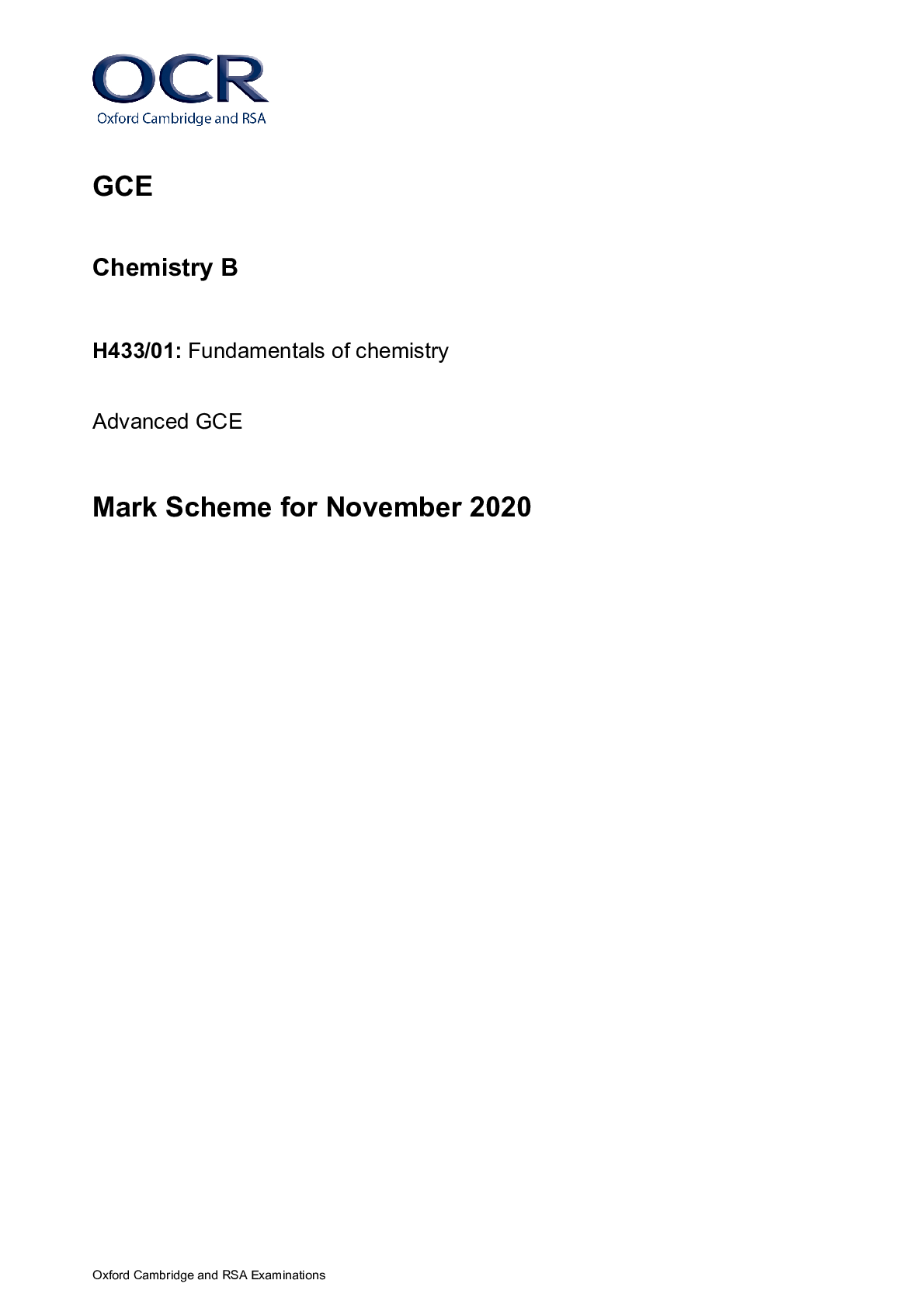
Reviews( 0 )
Document information
Connected school, study & course
About the document
Uploaded On
Oct 07, 2022
Number of pages
16
Written in
Additional information
This document has been written for:
Uploaded
Oct 07, 2022
Downloads
0
Views
35



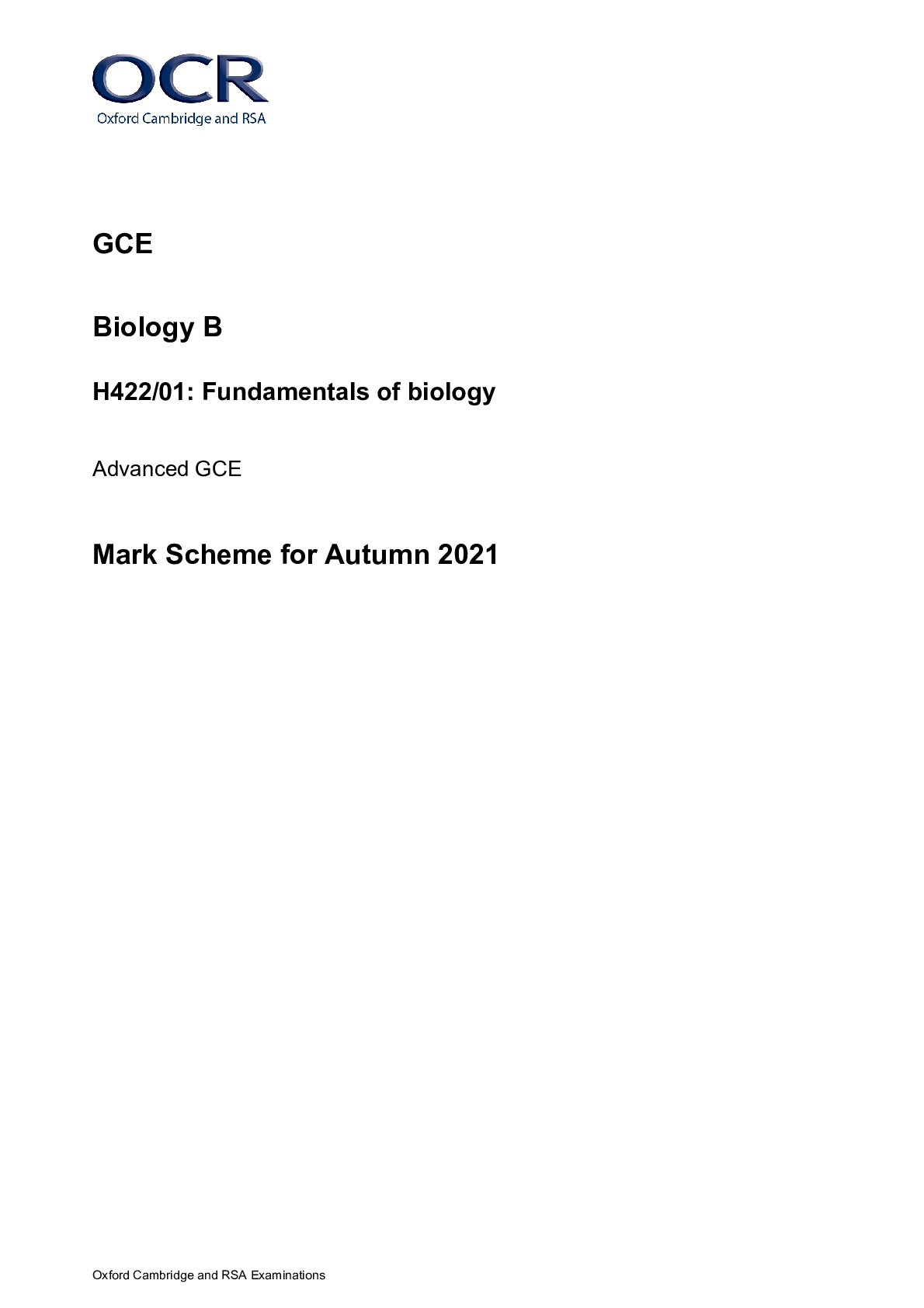
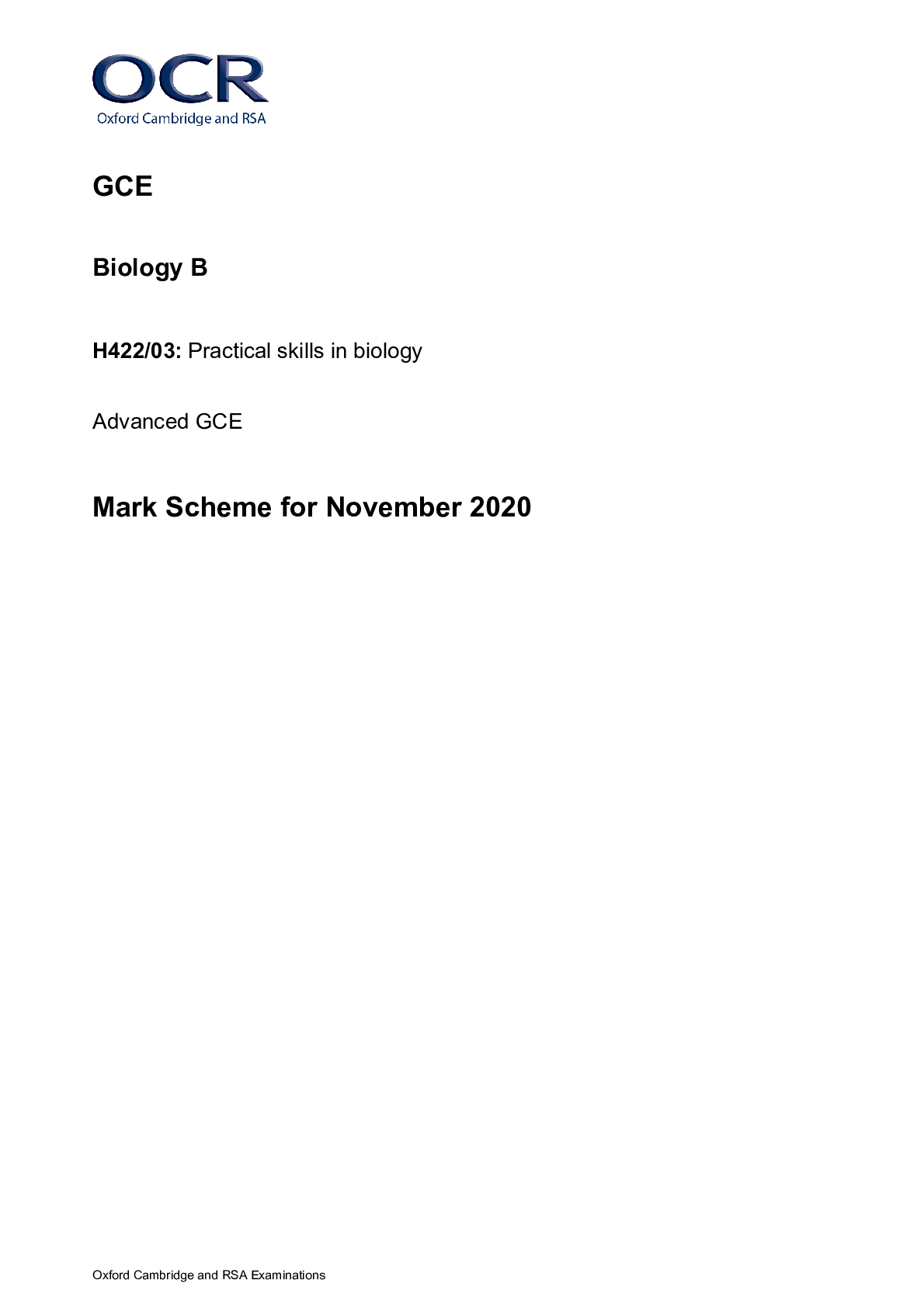
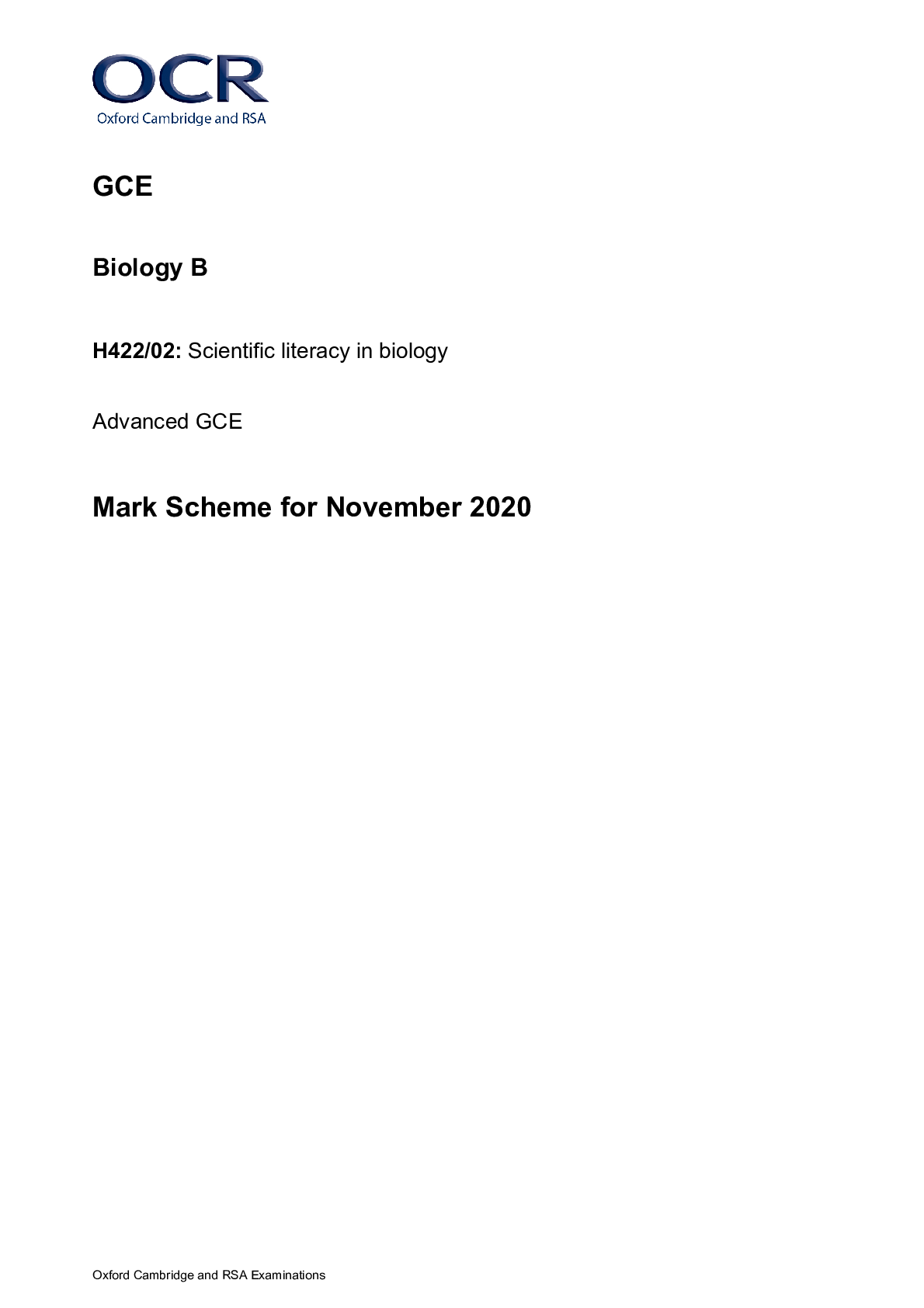
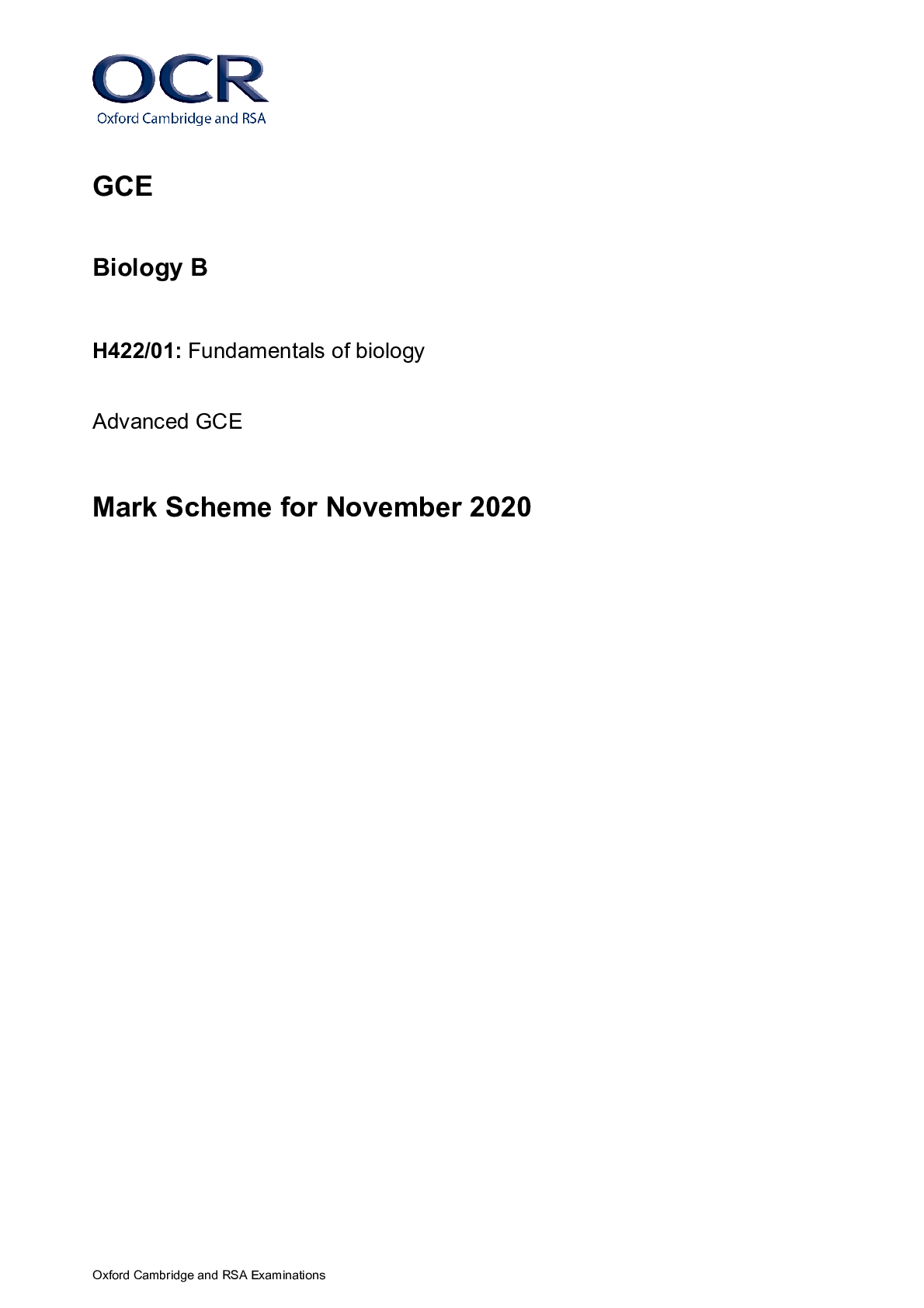

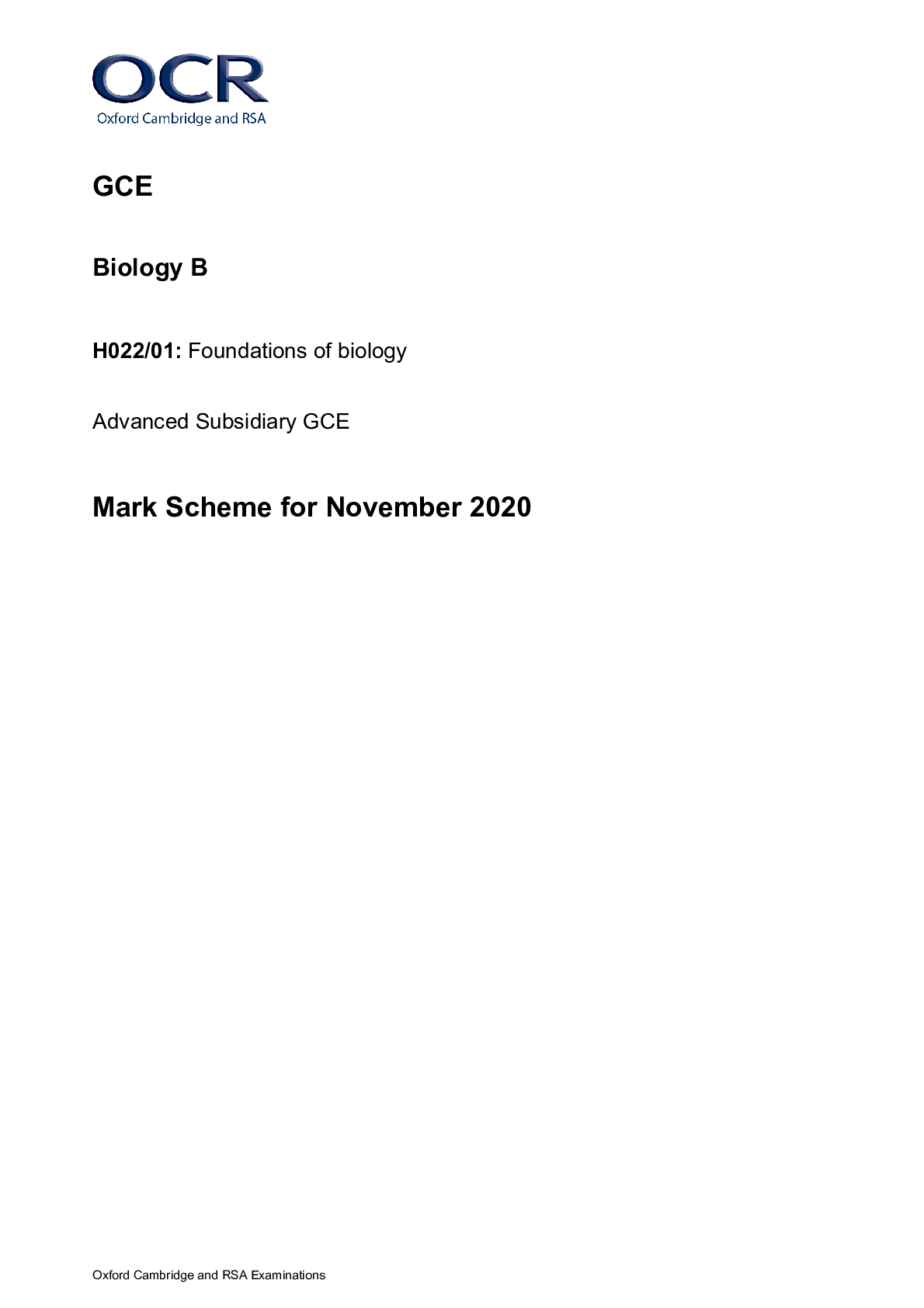
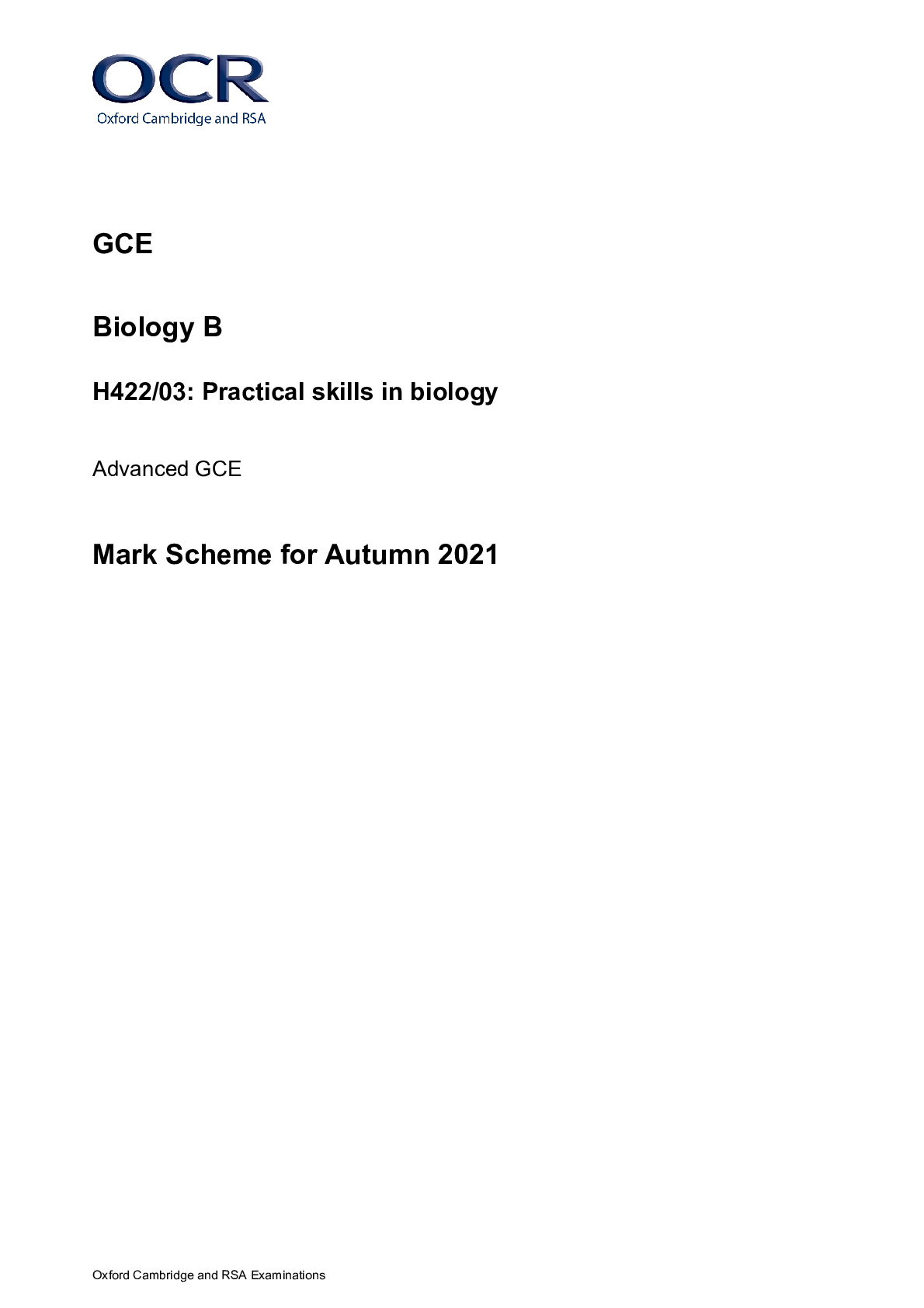
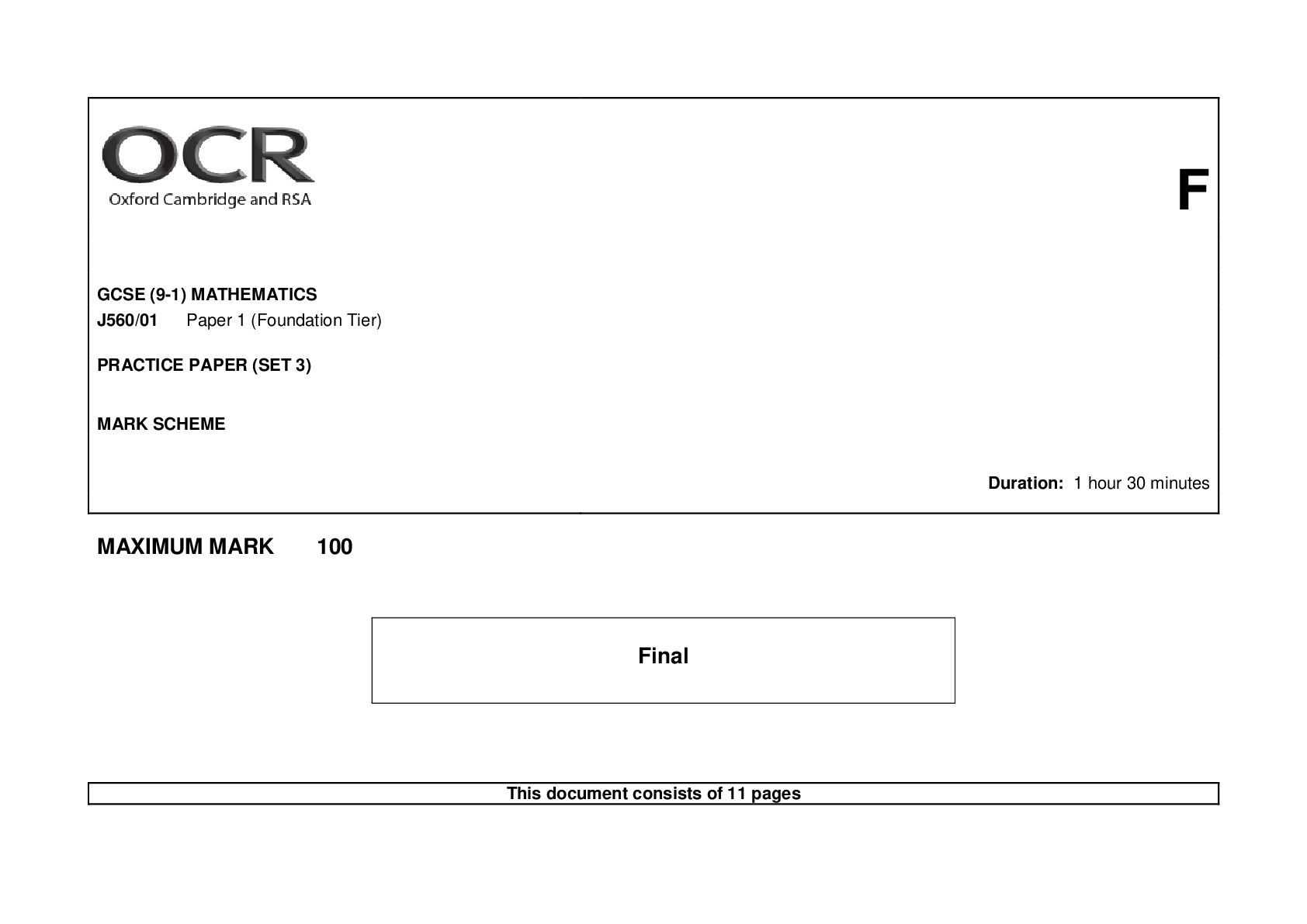
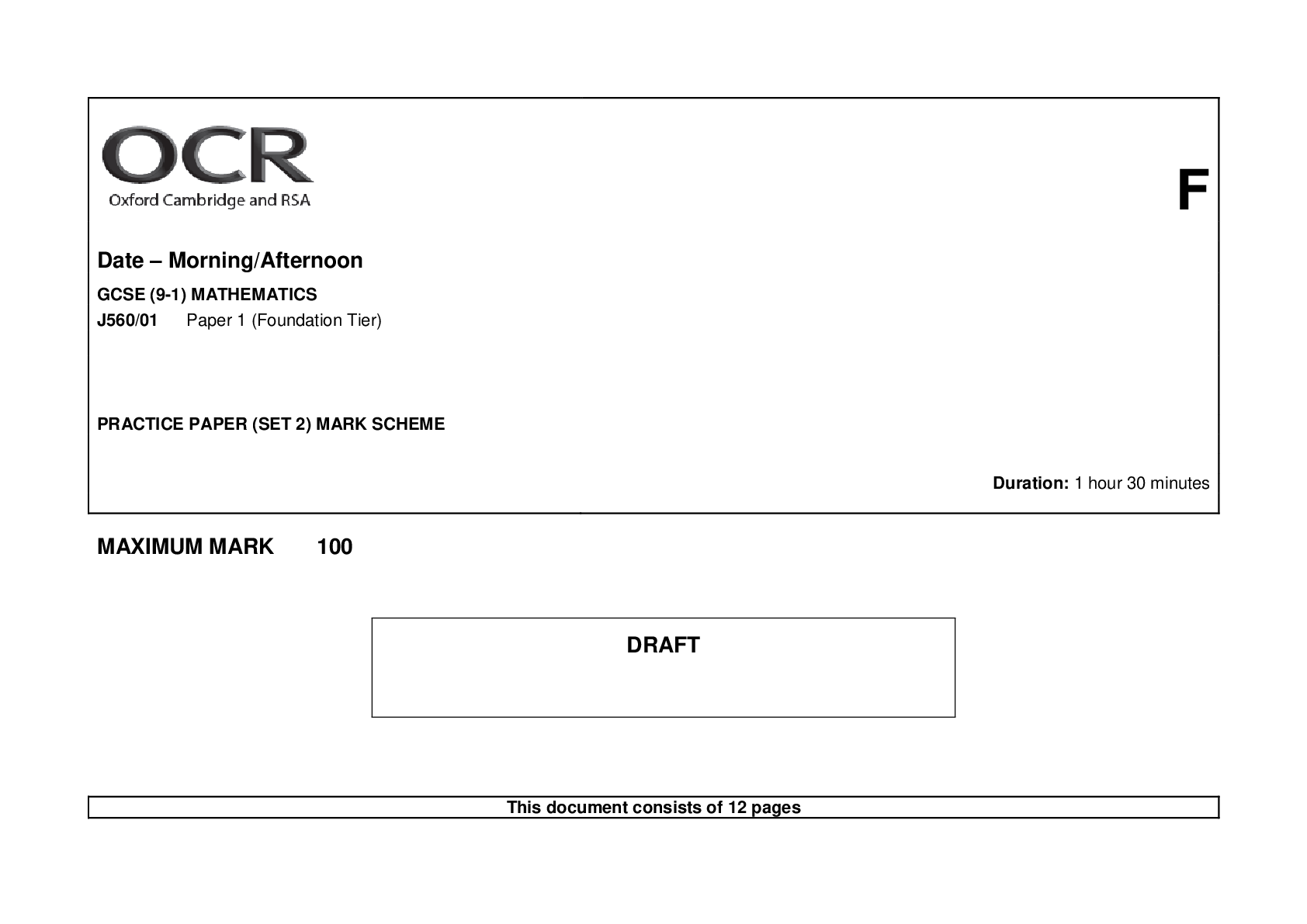
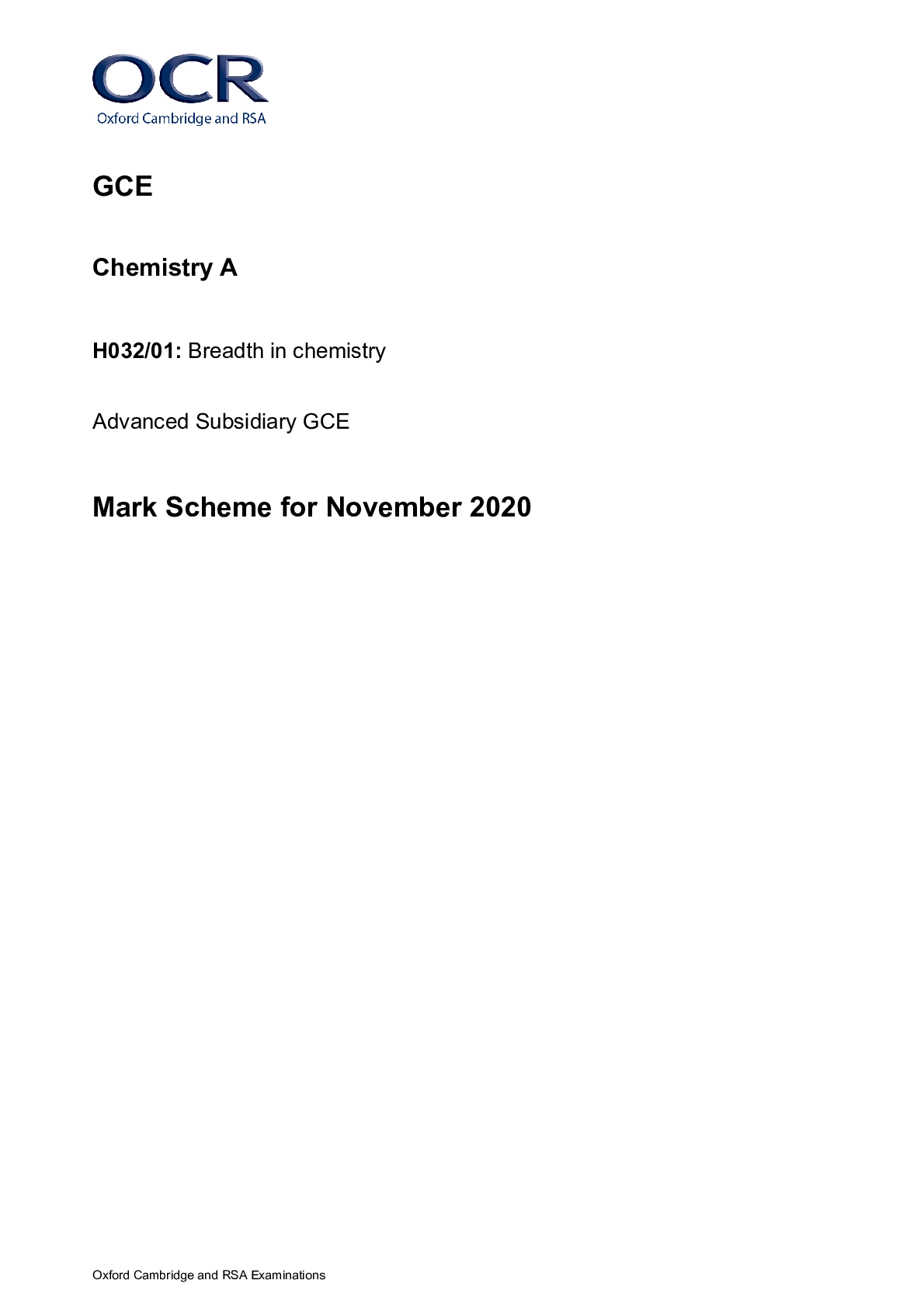

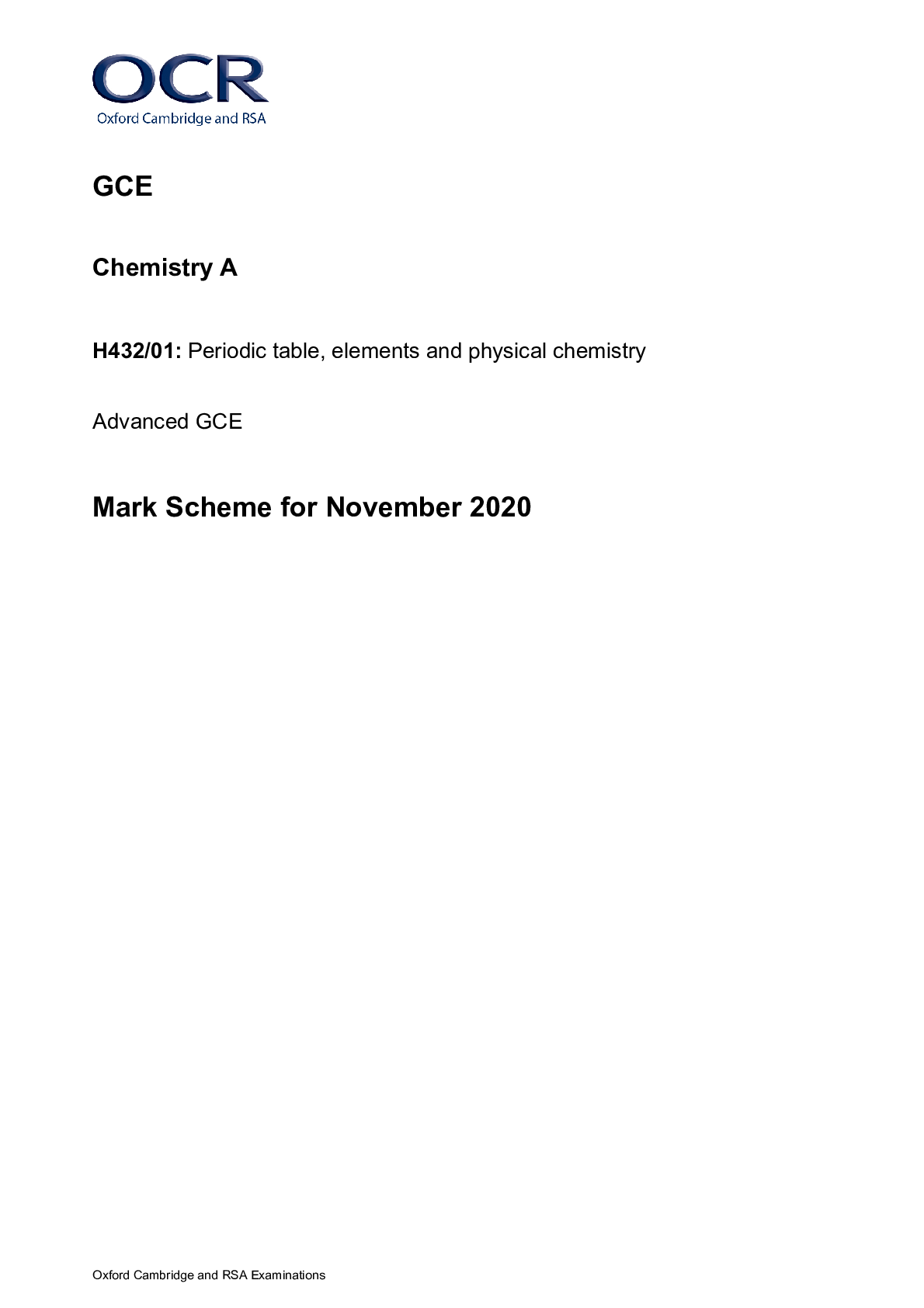
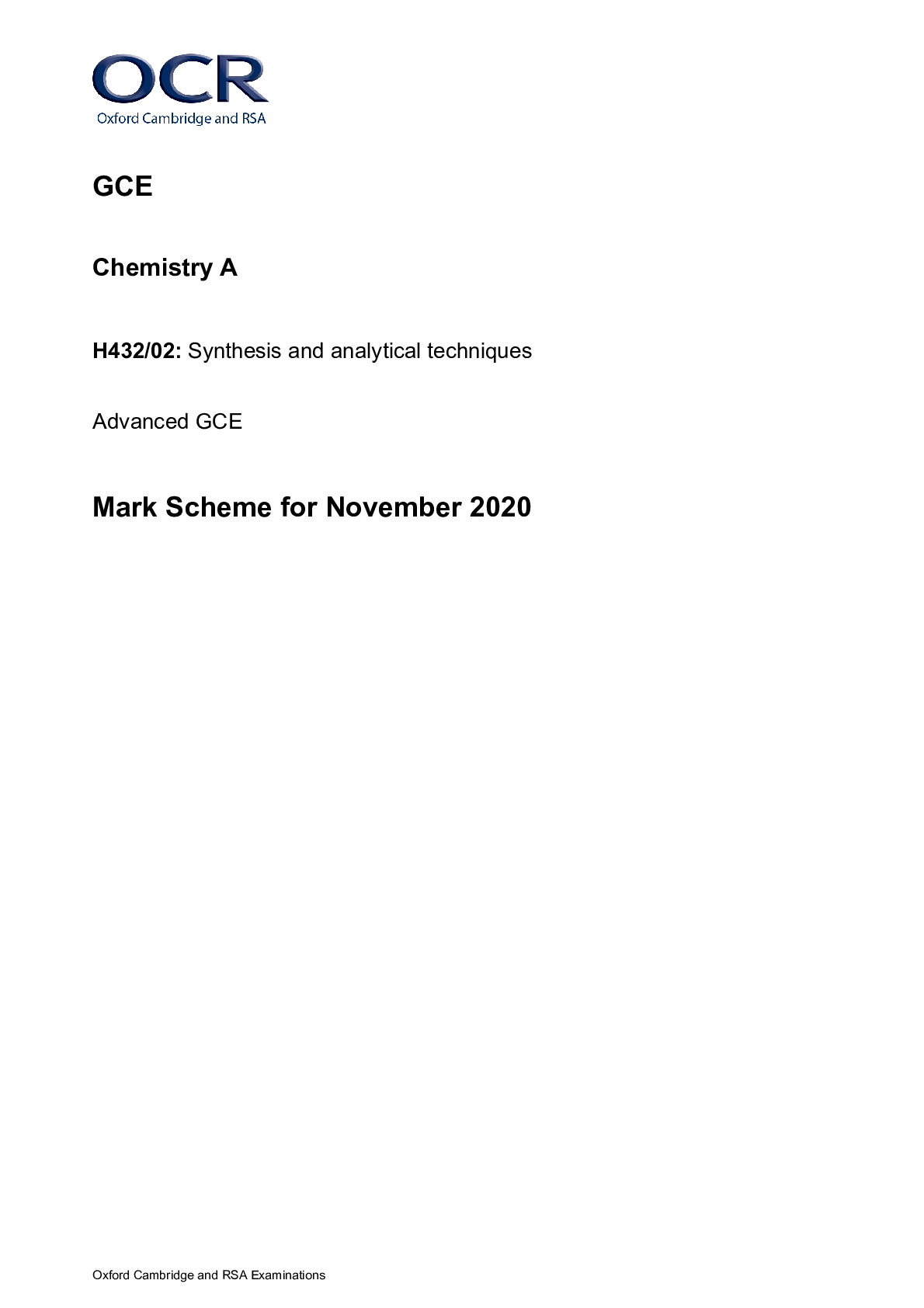

H630-02 Pure Mathematics and Statistics Advanced Subsidiary GCE Mark Scheme for Autumn 2021.png)


.png)

